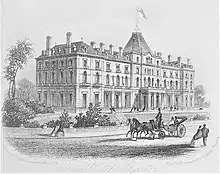| Palace Hotel | |
|---|---|
 Devonshire Dome and Palace Hotel | |
| General information | |
| Town or city | Buxton, Derbyshire |
| Country | England |
| Coordinates | 53°15′39″N 1°54′53″W / 53.2608°N 1.9148°W |
| Construction started | 1864 |
| Completed | 1866 |
| Design and construction | |
| Architect(s) | Henry Currey |
| Designations | |
Listed Building – Grade II | |
| Designated | 18 October 1994 |
| Reference no. | 1258009 |
| Website | |
| Official website | |
The Palace Hotel was opened in 1868 in Buxton, Derbyshire, England. It holds a prominent position in the town's central Conservation Area overlooking the town. It is a Grade-II listed building.[1]
It was built from 1864 to 1866 as the first-class Buxton Hotel on the hill next to Buxton's two new railway stations. It cost £50,000 to build and had 105 rooms, a grand ballroom and 5 acres of landscaped gardens with croquet lawns and a tennis court. After its construction, the venture was liquidated and the hotel was auctioned in November 1867 at the Waterloo Hotel in Manchester. It was bought for £20,000 by a consortium including several of the original investors, the Duke of Devonshire and with the LNWR railway company as a major shareholder. It opened as the Palace Hotel in May 1868. It was the largest hotel in Buxton until the luxury Empire Hotel with 300 rooms was opened in 1903 (although the Empire never reopened after World War I and was demolished in 1964).[2][3][4]

The three-storey Palace Hotel is built of millstone grit stone and was designed in the style of a French château (with a Mansard roof with iron ridge railings and a central tower) by Henry Currey. Currey was the 7th Duke of Devonshire's architect and he also designed Buxton's St Ann's Well of 1852, Thermal Baths, Natural Baths, Pump Room, Market Hall, Holy Trinity Church, Congregational Church, Devonshire Park Chapel, Christchurch at Burbage, Wye House Asylum and Corbar Hall. Fellow architect Robert Rippon Duke was the Clerk of Works for the hotel's construction and he designed the grand marble-decorated extensions to the building in 1887, including a large new dining room at the rear and a new west wing.[3][5][6]
The hotel was an annexe to the Granville Military Hospital during World War I and used to billet British soldiers and later as a discharge centre for Canadian soldiers. After World War II (when the hotel was used as offices for the British civil service) the Palace Hotel was reopened by the Hewlett family, who also ran the Spa Plaza Hotel (formerly the Buxton Hydropathic). The red neon PALACE HOTEL sign on the tower is a distinctive sight in the town.[3][7]
Football teams including Manchester United, Manchester City, Nottingham Forest and Southampton stayed at the Palace Hotel in the 1950s as a health resort.[6] George Bernard Shaw, Douglas Fairbanks, Mary Pickford and Margaret Thatcher are some of the famous guests who stayed at the hotel. The hotel is now part of the Britannia Hotels group and it has a spa, gym, indoor pool and conference rooms.[7][8][9]
See also
References
- ↑ Historic England. "Palace Hotel (Grade II) (1258009)". National Heritage List for England. Retrieved 10 June 2020.
- ↑ Roberts, Alan (2012). Buxton Through Time. Amberley Publishing. p. 24. ISBN 978 1 4456 0817 4.
- 1 2 3 Leach, John (1987). The Book of Buxton. Baracuda Books Limited. pp. 75–78, 95–99, 124–127. ISBN 0 86023 286 7.
- ↑ Morten, David (2018). Buxton in 50 Buildings. Amberley Publishing Limited. ISBN 9781445678948.
- ↑ Morris, Mel (April 2007). "Buxton Conservation Areas Character Appraisal" (PDF). High Peak Borough Council. Retrieved 10 June 2020.
- 1 2 Langham, Mike (2001). Buxton: A People's History. Carnegie Publishing. pp. 63, 178, 215. ISBN 1-85936-086-6.
- 1 2 "Palace Hotel Buxton | Britannia Hotels". www.britanniahotels.com. Retrieved 10 June 2020.
- ↑ "Palace Hotel". www.wondersofthepeak.org.uk. Retrieved 10 June 2020.
- ↑ "Celebrating 150 years of the Palace Hotel Buxton". Discover Buxton. 31 May 2018. Retrieved 10 June 2020.